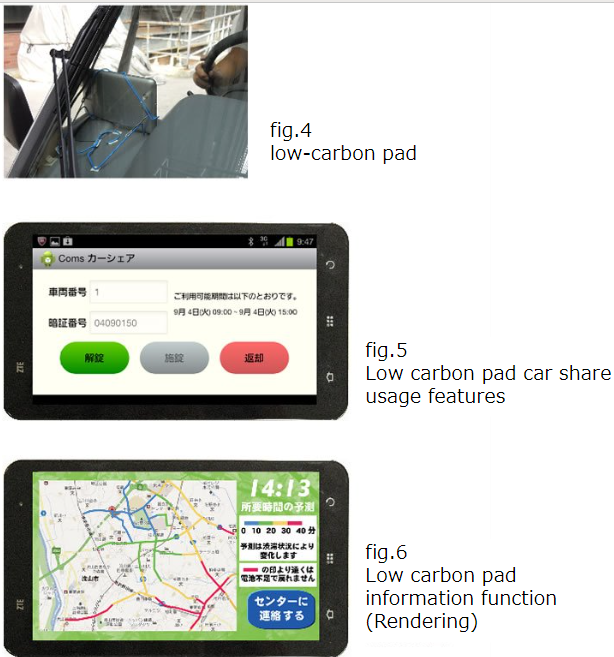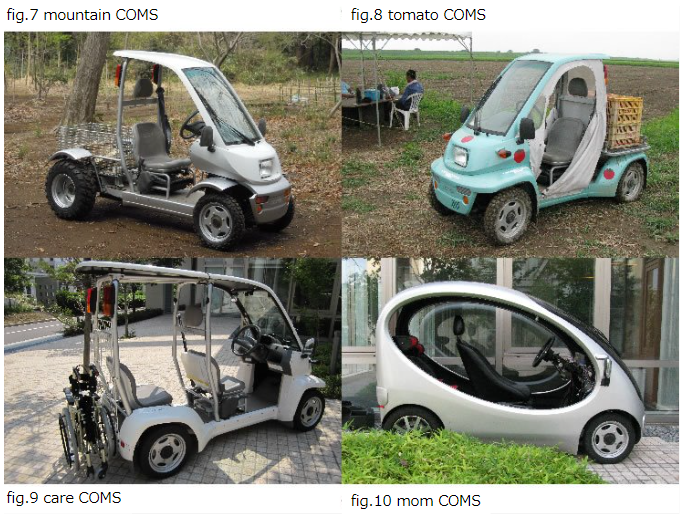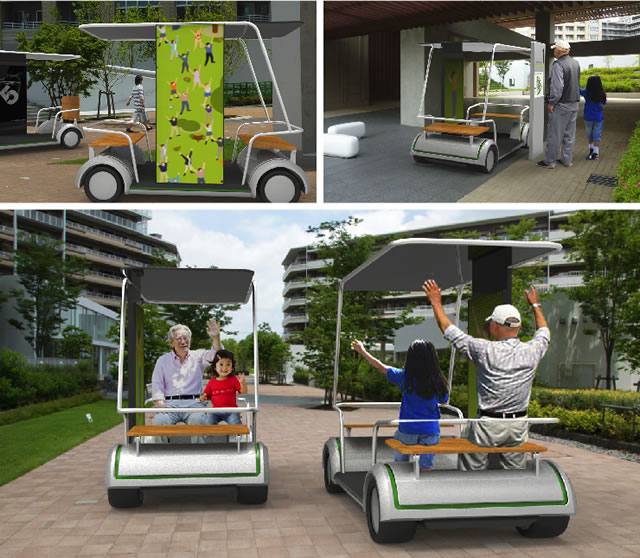Next-generation mobility that activates “short-distance, one-person journeys” improves regional mobility.
Responding to diversifying lifestyles is not a challenge limited to public public transport systems. At Kashiwa ITS Smart City, research and development of private next-generation mobility from a new perspective is underway, and is steadily approaching practical implementation.
As with public transport systems, mobility development to date has been based on the premise of medium- to long-distance travel by family units, with the development and production of family-type vehicles with seating for four to seven people as the mainstay. In reality, however, there are many opportunities to use one mobility vehicle per person for weekday daytime shopping and commuting, creating significant waste, which is a major cause of traffic congestion and increased CO2 emissions. It is also clear that the development of compact mobility for short-distance one-person journeys is lagging behind, despite the fact that, with the exception of special cases such as excursions, most of the journeys are daily and familiar.
The Kashiwa ITS Smart City is conducting demonstration tests of next-generation mobility for activating such short-distance, one-person journeys. The development of vehicles that are easy to operate even for the elderly and can be used easily and safely, as well as new mobility that maximises energy efficiency, will be combined with next-generation public transport systems to make them more convenient and enhance the mobility and circulation of the community.
Social implementation of micro-mobility
1. making going out more accessible!
The University of Tokyo’s Urban Transformation Programme for a Bright Low Carbon Society and the Research Institute for Ageing Society are researching what kind of vehicle would be best for the elderly to go out more easily. Electric vehicles that are small, lightweight, safe and can be recharged at home would be very convenient for daily use. On the one hand, ultra-compact electric vehicles have the advantages of easy manoeuvrability, access to narrow roads and low maintenance costs, but they also have problems such as short driving distance on a single charge, long charging time, anxiety in the event of a collision, legal requirement for single-seaters only and low horsepower.
The group is currently using a commercially available ultra-compact electric vehicle called COMS (manufactured by Toyota Motor Corporation) to investigate whether such a small electric vehicle can be used conveniently for daily use and whether there are any safety issues. The vehicle in the photo is fitted with a device called a drive recorder, which records and analyses the forward video, speed and position travelled.
The experiment is being conducted in the area centred on the Kashiwa Campus of the University of Tokyo, as shown in the map below. This area includes residential areas, rural and flat forest areas (Oaota), arterial roads (National Route 16) and commercial areas in front of stations (Kashiwanoha Campus and JR Kashiwa Station). In such areas, we actually drive around to find out whether it is convenient to carry out various daily errands and whether there are any hazards.
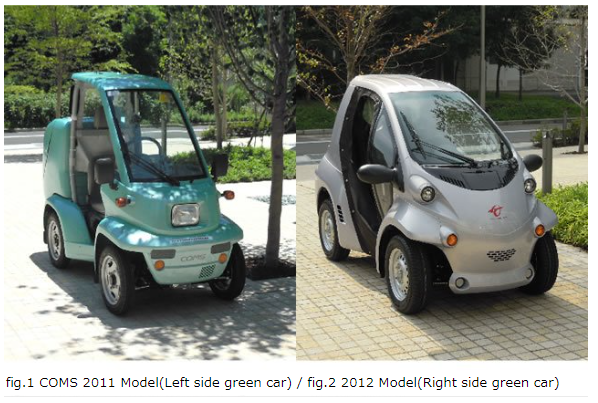 [Length x width x height and weight]
[Length x width x height and weight]2 m – 2.4 m × 1.0 m × 1.6 m, 310 kg (2011) / 2.4 m × 1.1 m × 1.5 m
・410 kg (2012)
[Driving range per charge]
40 km (2011) / 50 km (2012)
[Maximum speed]
55 km/h (2011)/60 km/h (2012)
Rechargeable at 100 V AC for household use.
[Price]
Approx. 800,000 yen (2011) / 670,000 yen (2012, unpainted)
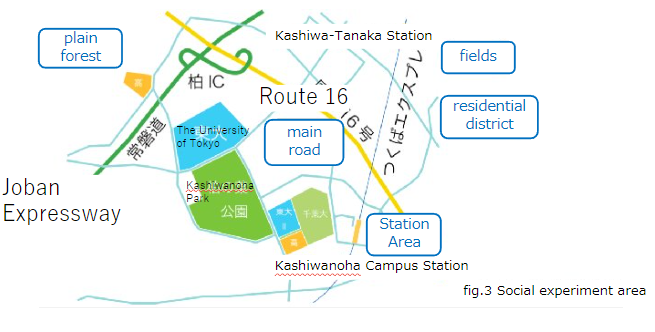
2. the development potential of ultra-compact electric vehicles
Pure electric vehicles, which use storage batteries as their power source, are currently being introduced in Japan. The Mobility Group is conducting research to popularise pure electric vehicles in society from a new perspective that is not bound by conventional views. One research theme is ‘wireless power transfer’, which is detailed on a separate page. Another is a car-sharing reservation and information system using a versatile, dedicated tablet-type terminal. This involves users holding a dedicated tablet device called a ‘low-carbon pad’, which they use to make car-share reservations and which also acts as a power key when they actually get in. The terminal can also be used as a drive recorder (a device that records video footage, position, speed and other data while the vehicle is in motion) to provide information on road conditions and recommended facilities to the destination.
3. Proposals for various applications
Current lead-acid battery and lithium-ion battery electric vehicles still face challenges in terms of cruising range and recharging time, if they are to be used in the same way as conventional vehicles. The Mobility Group is proposing new, unprecedented uses for the Coms, an ultra-compact electric vehicle with a narrow vehicle width, in order to make the most of its characteristics and promote its widespread use in society. The ‘Yama Comms’ for entering mountainous forests with trees that light trucks cannot enter and carrying out forest maintenance work, the ‘Sato-Comms’ for outdoor work in suburban residential areas and the ‘Tomacomms’ for harvesting tomatoes in soft field areas are an attempt to expand the use of ultra-compact electric vehicles not in cities but in forests and farmland.
A two-seater vehicle has also been developed and is being investigated to see if it can be used successfully in practice; the two-seater vehicle can be used by couples, to take family members to and from the hospital, etc. Hooks can be attached to the rear and wheelchairs can also be carried (called ‘CareComs’). The vehicle will apply for certification so that it can be driven on public roads in a two-seater configuration.
We have also developed the two-seater vehicle into a prototype called ‘Mamacoms’, which can carry two children in the rear seat. If such vehicles are offered at a lower cost, it would help to reduce the number of dangerous three-person rides by mother and child on bicycles.
In this way, ultra-compact electric vehicles with narrow vehicle widths can be considered for unprecedented applications, enabling activities that were previously impossible due to a lack of suitable means of transport to be carried out without difficulty. If they lead to the revitalisation of mountain forests and agricultural lands, CO2 absorption can be expected to increase, and if they facilitate urban life, urban structural change and a reduction in urban CO2 emissions can also be expected.
Automatic community carts – Preliminary testing of an ‘automatic community cart’ that travels around the community without the need for a driver.
Preliminary testing of a next-generation mobility concept that uses electromagnetic induction technology and small electric carts to support the safe and easy mobility of the elderly and children in the community will commence in October 2013. The automatic community carts are designed to automatically travel along a route with electromagnetic induction lines, with users calling up the vehicle at a number of stations along the route and setting their destination. The carts will be equipped with safety-conscious control technology, such as automatic stopping when pedestrians approach the vehicle while it is moving.
This initiative is being implemented by the University of Tokyo’s Gerontology Network for University-Industry Collaboration, in collaboration with the Kashiwa ITS Promotion Council, which aims to create new value, industry and innovation for the super-aged society. Preliminary tests are being conducted in Park City Kashiwanoha Campus Nibangai, an apartment block near Kashiwanoha Campus Station with a total of approximately 880 households, and preliminary verification of usage needs, convenience and safety is being conducted with a view to developing a full-scale social experiment in 2014. The aim is to create a social system that will lead to the revitalisation of the local area and the promotion of interaction by increasing opportunities for citizens to get out and about by eliminating the inconvenience of transport caused by age, physical condition, large amounts of luggage and children in tow.

